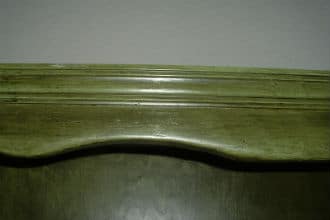So, what is the saber saw used for? Do you swing swords in order to chop wood into pieces? No, you don’t. Actually, there is a lot of confusion about the name. I’ll try to clarify things:
The Saber saw is a portable woodworking tool and can also be called a Sabre Saw or a Jig Saw. This tool makes curved cuts in a piece of wood. I wrote another article called: What is a Jigsaw?
Another tool used to cut curves is the scrolling saw. However, it’s a non-portable tool and usually comes with a table-top surface. The blade moves up and down in order to cut the wood. Also, the blade is attached to the saw in two places (top and bottom).
The Saber Saw has a blade similar to that of the scrolling saw. However, it’s usually less flexible and is only attached to the tool in one place (the top).
Actually, the Saber Saw is a type of Reciprocating Saw. It’s in this family because it cuts by moving the blade back and forth. However, it this article we will only be dealing with the Saber Saw (Also called the Sabre Saw or Jig Saw). This is because the Saber Saw is used in fine woodworking and furniture making. However, the other reciprocating saws are primarily used for rough cutting and similar work.
The Saber Saw has a base and sits on top of the piece of wood you wish to cut. You may be able to control the cutting speed with a hand trigger control. With some models, you are able to turn the blade with a knob on the top. Otherwise, you can turn the blade by moving the Saw itself.
These versatile tools can cut all sorts of materials, such as metal, plastic, tile, etc. However, we will only be giving examples of cuts in wood, plywood, or wooden paneling:
1. Scrolled Curves in Plywood
The Saber Saw can be used to cut curved shapes in plywood. You can make things like scrolled signs or decorations.
If you make too sharp a cut or turn the saw too quickly, you might break the blade. You can avoid this by taking your time and cutting slowly.
Generally, you draw a curve on the wood and would like to use the saw to cut out that shape. However, the blade has a definite thickness. The width of the wood cut out by the blade is referred to as the kerf. You want to position the saw to the side of the line so that the kerf is accounted for and the cut piece will be the proper size.
Also, the up and down blade motion in a Sabre Saw can easily cause the wood to splinter. It can also make the cut very rough. As a result, you might need to spend extra time sanding the cut edge. You can usually avoid this problem by using a fine-toothed blade.
2. Decorative Scrolls For Furniture
You can also make decorative scrolled pieces of wood. Generally, you want to keep the thickness of the wood under 2 inches or so, so you do not put too much stress on the blade when you make a turn. Also, the saw motor might not have enough power to work well with thicker wood.

Even with a fine-toothed blade, the Saber Saw cut will be rough and need sanding. You can often utilize a sanding drum accessory for a portable electric drill to help with this. Also, sanding drums can often be used with drill presses.
So, what happens if the sanding drum is too big to fit into a curved cut? This can happen if the curve is very sharp. To deal with this situation, you can use a smaller drum, use a hand tool such as a file or rasp on that section, or sand that part by hand.
3. Cutting Wooden Piece to a Custom Shape
Many times, you need to cut a piece of wood into a custom shape. As an example, suppose you’re putting up a sheet of paneling in a part of the room with a slanted roof. Then, you would need to cut the top to fit in the slanted section.
For another example, suppose you needed to put the paneling piece over a window. You would need to cut a custom shape so as to clear the window when the paneling is put on the wall.
4. Some Ripping
The Sabre Saw is also capable of Ripping. By this, I am referring to a cut along the grain, so that the wood is sliced into two boards.
Generally, you use a guide for the Saw. The end of the guide rests along the edge of the wood, and a piece extends from that end at a 90-degree angle. This piece is attached to the Saw and keeps it at a constant distance from the edge of the board.
While a Saber Saw can make this type of cut, it’s not the best tool for the job:
- The motor usually does not have that much power – As a result, the cut is very slow and it takes a long time to make it.
- The cut is not very accurate – If the guide slips off the edge of the board, the cut will be off.
- You are assuming that the edge of the board is perfectly straight-This may not be the case. If the edge is not straight, the guide will not hold the saw on a constant line as you move the saw along the board.
- The cut will be rough – So, it will need plenty of sanding, and the wood may splinter.
A better solution is to use a Table Saw, Circular Saw, or Radial Arm Saw. These have more power and make cleaner cuts (with a fine-toothed blade). Also, they will be more accurate and it will take less time to make the cuts.
5. Some Crosscutting
In this case, you use the saw to cut across the grain of the wood.
However, it is not the preferred tool for this operation. As far as power tools, a Table Saw, Circular Saw or Radial Arm Saw should be able to make much cleaner cuts. They should also take less time and be more accurate.
Also, a Miter Box can be used for this. Make sure the saw has a fine-toothed blade. It might be a good idea to practice with a piece of scrap wood to see if the cuts are satisfactory.
6. Interior Cuts
This is a cut inside the piece of wood, rather than along an outside edge. As an example, you might want to put a piece of paneling over an outlet box. How are you going to cut an opening for the outlet?
First, you would have to mark the sheet of paneling to show where the outlet box opening should be. This can be done with a marker tool, chalk, or similar substance. You rub the tool on the outlet box and then press the paneling sheet into the desired position. The outline of the box then gets transferred to the paneling sheet.
Next, you need to cut it out of the interior of the sheet. You could do a plunge cut. That is, tilt up the saw on its base, bring the saw to full speed, and then tilt it down to that it cuts through the wood.
However, this is a good way to break the blade! A better idea is to drill a hole, larger than the blade size, inside the marking for the outlet box. Move the tool so as to insert the blade into that hole. Then, cut out to the marking line starting from that point.
7. Circular Cut
You can also use the Sabre Saw to cut out a circle. One approach is to draw the circle shape on the wood and then cut as you would with any other curve.
However, geometry tells us that all points on a circle are the same distance from the center point. So, if we use a guide or circle jig to keep the saw a constant distance from the center, the Saw will cut out a perfect circle.
8. Angle Cut
This versatile saw can also cut at an angle. To do this, change the angle of the base. Then, lock the base at this angle. You may need to refer to the manufacturer’s instructions to see how to do it with the particular model you’re using.
The Sabre Saw is still not the best tool to use for this. First, the cut will be rough, even if a fine-toothed blade is used. So, it will require extra sanding. Also, the angle cut might not be too accurate.
Better tools for this are the Table Saw and Radial Arm Saw.
Conclusion
In this article, we mentioned that the Saber Saw is also referred to as a Sabre Saw or a Jig Saw. It’s a portable tool and can be used in many ways. The Saw can cut all sorts of wooden material, including boards, plywood, and paneling. In addition, it can cut curved outlines as well as enclosed shapes in the interior of the wood.
Did you enjoy this post? If you, you might want to follow my boards on Pinterest.
Now, it’s your turn. Please feel free to make comments. Do you have anything to add?



I got good info from your blog